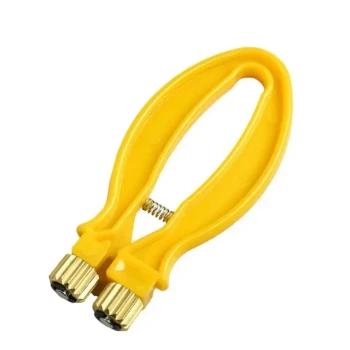The primary purpose of a slatted rack is to improve hive ventilation and reduce congestion at the entrance. Placed between the bottom board and the first brood chamber, this optional piece of equipment creates a "cushion" of space that helps regulate temperature and gives returning forager bees a place to cluster without crowding the brood nest.
A slatted rack is not an essential piece of hive equipment, but it is a powerful tool for proactively managing common hive stressors like heat, congestion, and irregular brood patterns.
How a Slatted Rack Solves Core Hive Problems
A slatted rack might seem like a simple wooden frame, but its design directly addresses several key challenges in beehive management. It functions as a sort of "front porch" or buffer zone within the hive.
Enhancing Ventilation and Temperature Control
In hot summer months, a hive's population works constantly to maintain a stable internal temperature.
The slatted rack provides a dead air space and an improved pattern of air circulation, allowing cool air to enter and hot air to dissipate more effectively. This reduces the heat stress on the colony.
Reducing Brood Chamber Congestion
Returning forager bees often land on the bottom board and immediately rush into the brood area, creating a traffic jam.
The slatted rack offers these bees a place to rest and cluster just inside the entrance. This frees up space on the brood frames, giving the queen uninterrupted room to lay eggs and reducing the colony's impulse to swarm due to perceived overcrowding.
Promoting a Fuller Brood Pattern
The bottom edge of brood frames can often be the coolest part of the hive, discouraging the queen from laying eggs there.
By improving airflow and creating a buffer from the direct entrance, the slatted rack helps normalize the temperature at the bottom of the brood chamber. This encourages the queen to lay eggs all the way to the bottom of the frames, resulting in a larger, more robust brood pattern.
Preventing Unwanted Comb Construction
Bees will often build "ladder comb" or "burr comb" in the space between the bottom bars of the brood frames and the bottom board.
The design of the slatted rack discourages this type of construction. This makes hive inspections cleaner and less disruptive, as you are less likely to roll bees or tear open comb when removing the first box.
Understanding the Trade-offs
While beneficial, a slatted rack is an optimization, not a necessity. It's important to understand its role in the context of your specific beekeeping goals.
It Is an Optional Component
Many beekeepers run successful apiaries for years without ever using a slatted rack. A strong colony in a suitable climate can manage its own ventilation and congestion perfectly well.
Added Cost and Complexity
For a new beekeeper, the priority is mastering the essential components: bottom board, brood boxes, frames, inner cover, and outer cover. A slatted rack is one more piece of equipment to purchase, build, and manage during inspections.
Potential for Pests
The additional space created by the rack could theoretically provide a hiding place for pests like small hive beetles or wax moth larvae. However, in a healthy, populous colony, the bees will effectively police this area, making this a very minor concern.
Is a Slatted Rack Right for Your Apiary?
Adding a slatted rack is a strategic decision based on your climate and management style.
- If your primary focus is simplicity and minimizing costs: You can manage a healthy hive without a slatted rack by focusing on proper hive placement and entrance management.
- If your primary focus is optimizing hive health in a hot climate: A slatted rack is one of the most effective tools for reducing heat stress and improving colony comfort.
- If your primary focus is maximizing brood production and preventing swarms: The rack's ability to reduce congestion and encourage a full brood pattern makes it a valuable asset for maintaining a strong, productive colony.
Ultimately, a slatted rack is a valuable upgrade that helps you move from simply keeping bees to proactively managing a thriving, efficient colony.
Summary Table:
| Purpose | Key Benefit |
|---|---|
| Ventilation | Improves air circulation to reduce heat stress. |
| Congestion | Provides a resting area for foragers, reducing traffic jams. |
| Brood Pattern | Encourages the queen to lay eggs in a fuller, more robust pattern. |
| Hive Management | Discourages burr comb, making inspections cleaner and easier. |
Ready to optimize your apiary's health and efficiency?
At HONESTBEE, we supply commercial apiaries and beekeeping equipment distributors with high-quality, durable slatted racks and other essential hive components through our wholesale-focused operations. Our equipment is designed to help you proactively manage your colonies for maximum productivity and swarm prevention.
Upgrade your hive management today – Contact our team to discuss your needs and request a wholesale quote!
Related Products
- Langstroth Screen Bottom Board for Beekeeping Wholesale
- Australian Pine Wood Langstroth Screen Bottom Board for Wholesale
- HONESTBEE Advanced Ergonomic Stainless Steel Hive Tool for Beekeeping
- Long Langstroth Style Horizontal Top Bar Hive for Wholesale
- Professional Drop-Style Hive Handles for Beekeeping
People Also Ask
- What are the cleaning benefits of using wire mesh in a beehive? Boost Hive Health & Efficiency
- What are the standard sizes of frames used in Langstroth hives? Choose the Right Frame for Your Apiary
- How can screened bottom boards assist with pest management in beehives? A Guide to IPM and Varroa Control
- How does the Screened Bottom Board help in mite prevention? A Guide to Monitoring & Control
- What are the benefits of using a screened bottom board in warm or humid climates? Boost Hive Health & Control Pests



















